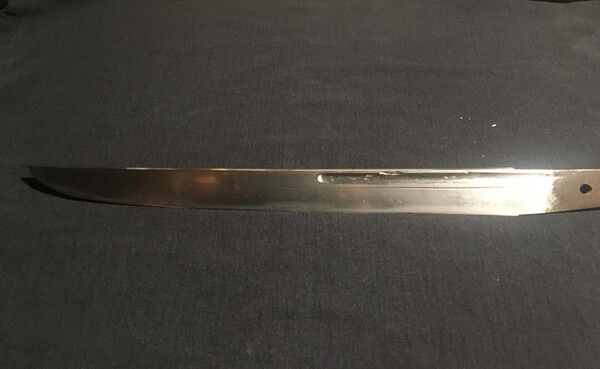
Aiden CC
Members-
Posts
9 -
Joined
-
Last visited
Profile Information
-
Location:
Colorado
Profile Fields
-
Name
Aiden CC
Recent Profile Visitors
153 profile views
Aiden CC's Achievements
-
Thank you Mark, that makes sense. Composite structures seem to be the norm for blades of all kinds in Japan, so I figured something like that may have been the case. I do have one polished kogatana, but the construction isn’t readily evident, part of that may be that it came with some corrosion in various places. Aiden CC
-
Kogatana and kozuka are a part of koshirae I have always found interesting, and there is a feature of kogatana blades that has stumped me. On polished examples, it can be seen that one side has a hamon, meanwhile the other has file marks (yasurime?) and sometimes mei. This would seems to imply that only one side is hardened, as those features would be quite difficult to apply to hard steel (or they are applied before yaki ire, but they seem to be quite clean). Does any one know how the metal for a kogatana blade is put together? It seems like ni-mai with hardenable steel on one side and iron on the other is one possibility, or maybe the hamon is applied highly asymmetrically, hardening only the surface of one side? Any insights would be appreciated. Thank you, Aiden CC
-
Thank you everyone for the replies, there's a lot of helpful information here. It makes sense that for yari, especially during periods with more conflict, might be made with efficient use of material and larger scale production in mind since, in general, a spear is a more dedicated battlefield weapon and less effective status symbol than a sword since it can't be worn around town. It also makes a weapon 6+ ft long with half the steel of a much shorter sword. Thank you Piers for the point about the kerikubi, I definitely need to study this type of blade more and information about yari seems to be much less abundant than it is for swords. If I recall, Koto swords were often thicker and more "heavily built" in general, could this be part of the same trend, connected to an era with more conflict than others? The cross section being homogenous makes sense to me, it would be tricky to make a composite that had hard steel in the right places without poorly placed weld lines. The only thing it seems could work would be something like a ni-mai kitchen knife, but sharpened on both edges. This would, however, put a weld line parallel to the hamon which seems like it could be unfavorable for aesthetic (and maybe structural) reasons.
-
@Bugyotsuji , that cross section is very helpful, thank you! Do you think the nakago has the same cross section? It seems like a lot of high carbon material to bury inside of the shaft, but there are also a lot of “luxury” features on nihonto in general so I guess I wouldn’t be surprised. Lap-welding (in a forge) of low carbon material was common for tangs on European swords all the way up toIt the 18th/19th century, IIRC, for material conservation and increased toughness. @Baba Yaga, you are correct about what I mean by welding. I came to nihonto appreciation through bladesmithing, and in that world “welding” primarily refers to bonding two surfaces by forging, so both folding of tamahagane and final construction (kobuse, etc) would be called welding. My day job involves the metallurgy of modern steels (mostly automotive sheet steels), so some of my terminology likely comes from there as well. I have been making my own hearth steel (orishigane in Japan) for the past few years and have made a few tanto, and am now thinking of making a yari. I have made a few hundred other knives but am fairly new to Japanese style swords. As for yari construction, my question is about the blade and how it attaches to the nakago. From the very helpful cross section above it looks like a Maru, Makuri, or maybe Kobuse turned on it’s “side”. The change in color towards the center could also be a gradient in hardening/carbon content from the surface to the interior unrelated to the original construction of the blade. When I talk about a lap weld, I’m talking about a joint like this: The overlap would be treated more elegantly (scarfed edges etc) to make a good forge weld, but this is the basic principle. This type of joint lets the high hardness material be towards the point and the high toughness material be towards the handle/shaft. European spears (and some yari it seems) use a conical socket with the head inserted and welded and I was wondering if yari had something analogous with a hard blade welded onto a tough nakago.
-
Essentially yes, and also how the pieces might be welded to get a “core” when you want the jacket of high carbon steel to go all the way around. Jean, that makes sense. I was confused as to why a piece of steel that looked so well refined would be welded to something that looked much less so. Do you think the black specs are corrosion that happed after polishing? I don’t know how they would be a polishing artifact unless maybe some chemical etching process was employed, which I have found to attack and darken weld lines in my own shop-made steel (sort of like orishigane). That’s the main feature that seemed like it could indicate a less refined material to me as silica inclusions from the smelt take a number of folds to refine/expel.
-
I recently have become somewhat interested in yari (as a collector and a bladesmith) and have noticed while looking at pictures of blades in decent polish that it seems like the nakago (if that is the right word) and the base of the blade appears to be made from a coarser material. You can see it fairly well in this photo from eBay: I have seen something like this on other examples, to me it looks a lot like the slag inclusions I have seen in old puddled wrought iron (though this would be bloomery iron if that's what it is). Does anyone know how these blades were welded up before final forging? It seems almost analogous to the wrought iron socket welded on to European spear blades, but from images it's very hard to tell where the weld line might be. Since the blade is double sided and shows a hamon on all three faces, it seems like it would be hard to wrap hardenable steel around a core, so my best guess would be a lap weld somewhere, but it's hard to pick out. Any insights would be appreciated, Aiden CC
-
Thanks everyone for the ideas about the age and school! It's definitely cool to think it's likely 400+ years old. And peter, I was just about to ask about the what might suggest it to be Koto Mino, thank you for good explanation. Also, on a somewhat unrelated note, what would be the word for the type of hamon on this blade? Just from looking at diagrams, it seems it might be midare? Although in some places it seems like it "jumps" up slightly (you can sort of see it in the 5th picture of my first post) in a few places, rather than smoothly meandering. Sekigane might make sense for the tsuba (though there isn't a lot of room on the ha side), I think the main problem is the mekugi ana in the tsuka, which is poorly aligned with the one in the blade. There is a shim on the mune side inside the tsuka which makes it a tight fit, but also means the mekugi won't go all the way through. I know even less about koshirae than blades, does it seem reasonable that the set this blade is in may have been intended for a later tanto/wakizashi and modified to fit this blade? The saya is also somewhat longer than the blade (~2"), though not sure if that means it was meant for a longer blade.
-
I’ll work out a better lighting setup at some point to get better pictures of the whole hamon, for now here is a photo I already have of the side of the hamon not already shown above. Aiden
-
I have been collecting blades in a variety of styles for a while, for artistic value as well as measurements/inspiration for my own work, and I recently purchased my first Japanese blade. I'm fairly new to this kind of blade and would love some help on how I might get an idea of how old it is and any more provenance information as the blade didn't come with any and is unsigned. The length is right on the line between tanto and wakizashi. Also, it seems the blade has been re-polished a good bit, as the thickest portion is about 1" down into the nakago, the ubuha is almost all gone, and the hamon comes fairly close to the edge in a few places. I'm not used to photographing blades with traditionally polished hamons and had to improvise a setup, so I apologize for the glare in the pictures. The blade also came with a set of koshirae, but I think they were originally for another larger blade, except for the habaki. The tsuba/seppa have holes too big for the nakago and the mekugi doesn't pass all the way through the tsuka with the blade in it (despite what looks like a poor attempt by a previous owner at making it do so). The blade unfortunately also has some marks from what looks like a stone on a rotary tool in the hi and just above the habaki on the other side (like someone was trying to "fix" some openings in the hada). It's definitely in rough shape, but I mostly got it to study the sugata and hamon, which are there and for a fraction of the price that a blade in better shape would have been. Would it be a mistake to make a set of koshirae/a shirasaya for this blade? I don't think it's condition warrants putting money into having anything made for it, but it might be nice to see the blade in furniture that fits it properly. This is my first post here and I although I do have some knowledge of the craft side of these blades (though my own practical experience is limited to modern steels), I am entirely new to the collecting/connoisseur angle and any help is greatly appreciated. Thanks, Aiden CC

















